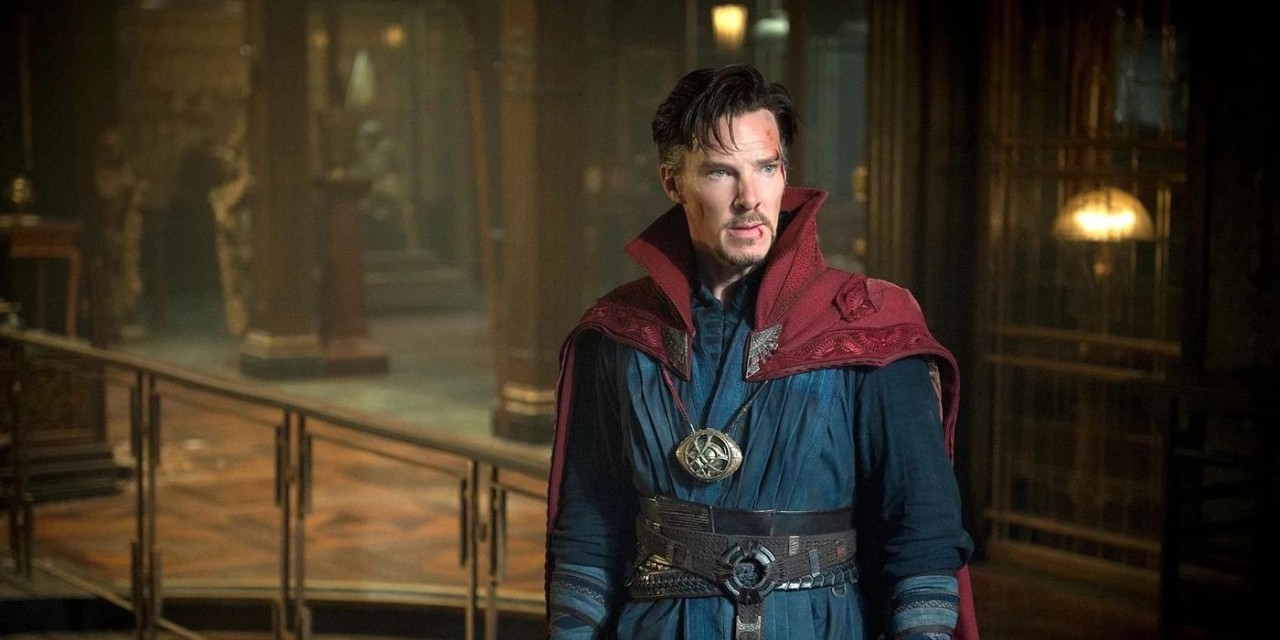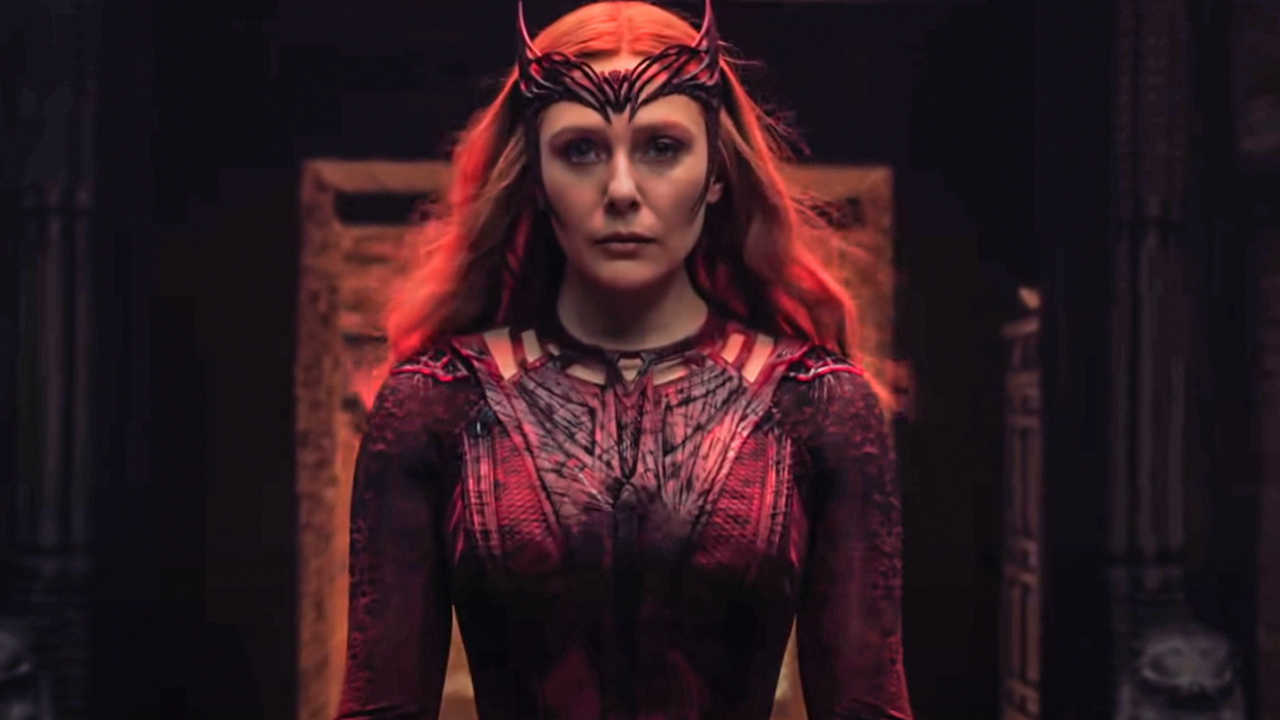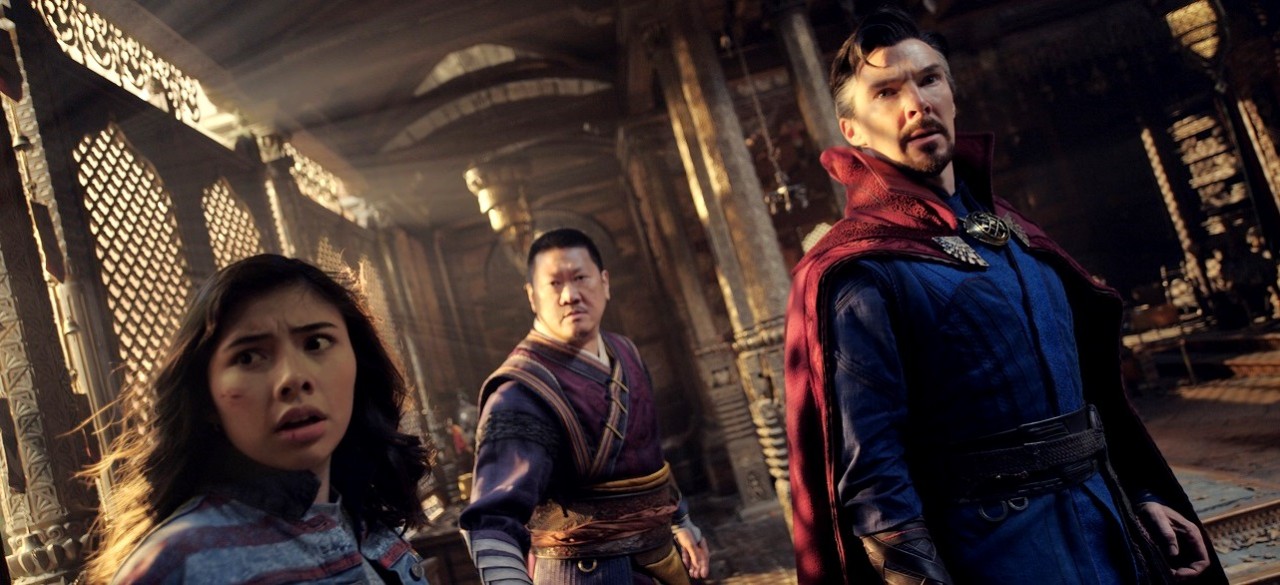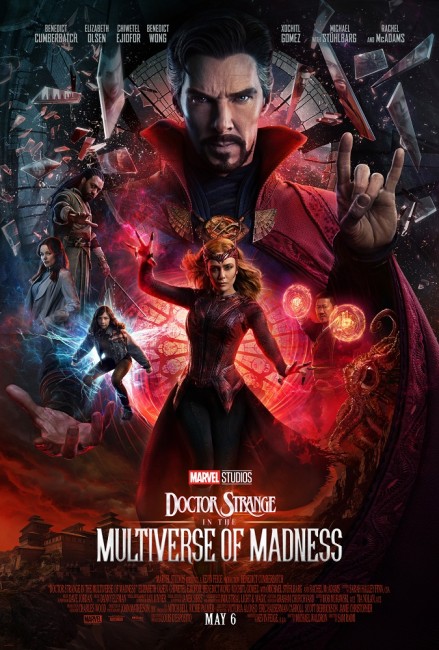USA. 2022.
Crew
Director – Sam Raimi, Screenplay – Michael Waldron, Producer – Kevin Feige, Photography – John Mathieson, Music – Danny Elfman, Visual Effects Supervisor – Janek Sirrs, Visual Effects/Animation – Digital Domain 3.0 (Supervisor – Joel Behrens), Industrial Light and Magic (Supervisor – Julian Foddy), Luma (Supervisor – Jared Simeth), Sony Pictures Imageworks (Supervisor – Theo Bialek) Trixter (Supervisor – Alessandro Cioffi)s & Weta FX (Supervisor – Erik Winquist), Visual Effects – Capital T (Supervisor – Jamie Hallett), Crafty Apes (Supervisor – Brandon Nelson), Framestore (Supervisor – Alex Wajsbrot), Perception, Spin VFX (Supervisor – Wesley Sewell), Special Effects Supervisor – Chris Corbould, Prosthetics Designer – Barrie Gower, Production Design – Charles Wood. Production Company – Marvel Studios.
Cast
Benedict Cumberbatch (Dr Stephen Strange), Elizabeth Olsen (Wanda Maximoff/The Scarlet Witch), Xochitl Gomez (America Chavez), Benedict Wong (Wong), Rachel McAdams (Dr Christine Palmer), Chiwetel Ejiofor (Baron Mordo), Jett Klyne (Tommy Maxmoff), Julian Hilliard (Billy Maximoff), Patrick Stewart (Professor Charles Xavier), Hayley Atwell (Captain Carter), Michael Stühlbarg (Dr Nic West), Lashana Lynch (Captain Marvel), Anson Mount (Black Bolt), John Krasinski (Reed Richards), Bruce Campbell (Pizza Poppa), Charlize Theron (Clea)
Plot
Doctor Strange is attending the wedding of Christine Palmer when a giant demon attacks in the streets outside. He and Wong save young America Chavez from the attack. Afterwards, America explains that she has the ability to travel across the multiverse and had just come from a world where Doctor Strange had been killed. Strange takes America to Kamar-Taj and goes to seek advice of Wanda Maximoff. He realises that Wanda has been using the powers of the Darkhold and has become corrupted by them. Wanda is seeking America’s powers so that she can conquer the multiverse and comes after her in an all-out attack on Kamar-Taj. In the course of this, America opens the way to the multiverse and Strange dives in with her. They end up in Earth 838 where Baron Mordo is the Sorcerer Supreme. They are captured by this universe’s version of Christine who works for The Illuminati, this world’s equivalent of The Avengers. Strange tries to warn them that The Scarlet Witch has the ability to Dreamwalk – take control of Wanda’s selves in other worlds of the multiverse and that she is inhabiting her self in this world to come after America.
Marvel Comics have enjoyed massive success in the 2000s/2010s. Following the success of Marvel adaptations produced by other studios, Marvel consolidated their properties into a shared world they called The Marvel Cinematic Universe (The MCU). This began with Iron Man (2008) and continued through the successive likes of Captain America: The First Avenger (2011), Thor (2011), Guardians of the Galaxy (2014), Ant-Man (2015), Black Panther (2018), Captain Marvel (2019), Black Widow (2021), Eternals (2021), Shang-Chi and the Legend of the Ten Rings (2021), The Fantastic Four: First Steps (2025) and Thunderbolts* (2025) and sequels to almost all of the above.
Doctor Strange, the Sorcerer Supreme and master of the dark arts was introduced by Marvel Comics in 1968. The idea of a magician as superhero was different to Marvel’s usual line-up of superheroes. The comic-book soon gained a cult following for its esoteric and frequently psychedelic artwork. Doctor Strange became one of their core characters and a member of The Avengers.
Doctor Strange has been adapted to the small screen before with the tv movie Dr. Strange (1978) starring Peter Hooten, a pilot for a series that never took off, and is better than you expect, and the animated Doctor Strange (2007). The character made his appearance in the MCU with Doctor Strange (2016) directed by Scott Derrickson with Benedict Cumberbatch in the title role. This was one of the better among the MCU films. Cumberbatch also appeared as Doctor Strange in Thor: Ragnarok (2017), Avengers: Infinity War (2018), Avengers: Endgame (2019) and Spider-Man: No Way Home (2021).

Scott Derrickson bowed out of directing Multiverse of Madness, being too busy with The Black Phone (2021). The reins have been handed over to Sam Raimi, a cult director on the basis of The Evil Dead (1981) and sequels, along with other films like The Gift (2000) and Drag Me to Hell (2009). (See below for Sam Raimi’s other films). Raimi of course has considerable experience with superheroes, having created the original, non-comic book screen superhero Darkman (1990). Not to mention Raimi’s trilogy of Spider-Man films with Tobey Maguire – Spider-Man (2002), Spider-Man 2 (2004) and Spider-Man 3 (2007) – which were fundamental in laying down the box-office success of Marvel properties that Marvel Studios were able to build on in creating the MCU. (In a regular Raimi in-joke, Bruce Campbell has a cameo as a street cart vendor that Benedict Cumberbatch casts a spell on to make him keep punching himself, which brings associations with The Evil Dead II (1987) that had Campbell fighting his own possessed hand).
Multiverse of Madness is essentially an extension of Spider-Man: No Way Home and the way it used the Multiverse concept to wind in the different screen versions of Spider-Man and other associated Marvel characters. Thus we get appearances from Patrick Stewart as Professor Xavier from 20th Century Fox’s now defunct X-Men franchise, as well as Anson Mount as Black Bolt from the tv series Inhumans (2017) and Haley Atwell from the Captain America films and tv’s Agent Carter (2015-6), plus introducing John Krasinski as Reed Richards for the future merging of the Fantastic Four into the MCU. The resurrection of a zombie Doctor Strange towards the end of the film seems to be Sam Raimi teasing an MCU appearance of Marvel Zombies.
On the other hand, my complaint with both Multiverse of Madness and Spider-Man: No Way Home, as well as the various multiverse crossovers that appear in DC’s Arrowverse on tv, is that they do nothing interesting with the concept. For them, the multiverse is nothing more than a way to wind in cameos from previous incarnations of the characters or alternate takes. I compare these to Justice League: The Flashpoint Paradox (2013) or Superman: Red Son (2020), which conceived entire alternate worlds based on changes in the canonical timeline and wish the MCU films could do something more imaginative. Everything Everywhere All at Once (2022), which came out two months before Multiverse of Madness, conducted a much more conceptually challenging and fun use of the multiverse concept.

As I sit down to watch Doctor Strange in the Multiverse of Madness, I felt that I was starting to experience Marvel Fatigue. Marvel was doing well up until 2019 and the end of their Phase 2. Then came the pandemic, which saw no less than eight tv series appear in the space of a year-and-a-half – The Falcon and the Winter Soldier (2021), Hawkeye (2021), Loki (2021- ), WandaVision (2021), Moon Knight (2022- ), Ms Marvel (2022), She-Hulk: Attorney at Law (2022) and Secret Invasion (2023). While tv seems the ideal place to take the MCU during lockdown, I am afraid that I don’t have the amount of hours of viewing time to devote to catching up with these. Not to mention that The Falcon, The Winter Soldier, Wanda Maximoff/The Scarlet Witch and Hawkeye are such one-dimensional characters in their big screen appearances that it leaves me with zero inspiration in wanting to devote the time to following them. The other aspect is the one that comes in trying to keep up with the current spate of Star Trek and Star Wars tv series is that the product being put out is of such inferior quality to what attracted you to the franchise in the first place – especially so in the case of the 2020s Star Trek tv series – that one has given up following them.
This immediately becomes a problem when it comes to Doctor Strange in the Multiverse of Madness, which is very much dependent on events established in WandaVision, especially regarding Wanda Maximoff having a split life where she lives in an alternate reality with two children. It is not that hard to work out what is going on, especially if you have read the basics of what WandaVision was about. On the other hand, I think that someone coming to see Multiverse of Madness as their first exposure to the MCU say in 20-30 years’ time would be utterly bewildered in trying to follow the film’s dependence on reference to past events and established continuity, not to mention offering up alternate versions of characters and a line-up of heroes not seen before.
This does underline the pitfall of the modern MCU where essentially Multiverse of Madness is a film playing to the choir – that is to say, it is made solely for people who are familiar with the franchise and has no interest in the casual viewer or anyone who has not fanatically watched all the other films and charted every Marvel end credits sequence. For example, when we learn here that Wong is the Sorcerer Supreme rather than Strange, who is traditionally meant to hold the title in the comics, I had to go and look back through MCU continuity as my memory was blank as to when Strange lost the title.

On its own terms, Doctor Strange in the Multiverse of Madness is watchable enough. Sam Raimi gives the superheroics an undeniable vigour. There is an entertaining sequence with Doctor Strange and Wong up against a giant octopus-like demon rampaging through the streets of New York – although the sequence felt like it was overshadowed by the highly amusing climax of The Suicide Squad (2021) with the team up against Starro the Conqueror. This is followed by an epic battle as Scarlet Witch invades Kamar-Taj and some very entertaining effects as Strange and America plunge through the multiverse, including at one point being rendered as animated and paint characters, or when Strange enters into a fight using animate musical notes. On the other hand, by the time of the climax, the film disappears into a series of sequential scenes with people conjuring glowing circles of sparks and mystical symbols in mid-air where it becomes eye candy that washes over you.
The MCU seems to have problems devising decent Super-Villains – the best of these was Thanos, while Loki has gained a following with some people (although Tom Hiddleston’s over-acting does nothing for me). The Scarlet Witch is one character that has interesting depths (even if you have to reference a whole tv series to understand them). She is the only characters of the MCU who has started as a superhero – a member of The Avengers even – before we see her having gone over to the dark side here. The whole idea of her having developed a fantasy life with an imaginary family and being driven by a desire to inhabit the alternate timeline where they exist gives unusual motivation to the character, even if Elizabeth Olsen’s playing of the role seems entirely by the book and lacking any interesting depths.
Sam Raimi’s other genre films include:- the splatter comedy The Evil Dead (1981) and its sequels The Evil Dead II (1987) and Army of Darkness (1992); the bizarre cartoonish crime drama Crimewave (1985); the dark superhero film Darkman (1990); the psychic thriller The Gift (2000), and the trilogy of Marvel Comics adaptations Spider-Man (2002), Spider-Man 2 (2004), Spider-Man 3 (2007), followed by the horror film Drag Me to Hell (2009) and Oz: The Great and Powerful (2013). Raimi also co-wrote the Coen Brothers fantasy film The Hudsucker Proxy (1994) and produces the zombie film The Dead Next Door (1989) under the pseudonym The Master Cylinder. Sam Raimi has also had some success with his Renaissance Pictures production company, who have been particularly enterprising in the field of television fantasy. Theatrically, Renaissance have produced the bizarre Lunatics: A Love Story (1991), John Woo’s American debut Hard Target (1993) and the Van Damme time-travelling action film Timecop (1993). On television, Renaissance have produced such genre works as the superhero series M.A.N.T.I.S. (1994-6), the smalltown Deviltry show American Gothic (1995) and then had enormous hits with the dual successes of the tongue-in-cheek revisitings of Greek myth and sword and sorcery with Hercules: The Legendary Journeys (1994-9) and Xena: Warrior Princess (1995-2001). These were followed by similar tongue-in-cheek series as Young Hercules (1998-2000), the futuristic Cleopatra 2525 (2000-2), the historical romp Jack of All Trades (2000-1) and the Evil Dead tv spinoff Ash vs Evil Dead (2015-8) and film reboot Evil Dead Rise (2023). Raimi also formed the Ghost House Pictures production company and co-produced the likes of the American remake of The Grudge (2004), Boogeyman (2005), The Messengers (2007), Rise (2007), 30 Days of Night (2007), The Possession (2012), Evil Dead (2013), Poltergeist (2015), Don’t Breathe (2016), The Unholy (2021) and the tv series Legend of the Seeker (2008-10) and 13: Fear is Real (2009) as well as Raimi Pictures that produced Crawl (2019), Umma (2022), 65 (2023) and Boy Kills World (2023).
Trailer here


